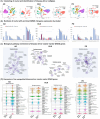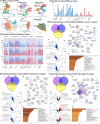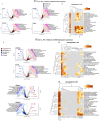Comparative mapping of single-cell transcriptomic landscapes in neurodegenerative diseases
- PMID: 40344336
- PMCID: PMC12061851
- DOI: 10.1002/alz.70012
Comparative mapping of single-cell transcriptomic landscapes in neurodegenerative diseases
Abstract
Introduction: Alzheimer's disease (AD), dementia with Lewy bodies (DLB), and Parkinson's disease (PD) represent a spectrum of neurodegenerative diseases (NDDs). Here, we performed the first direct comparison of their transcriptomic landscapes.
Methods: We profiled whole transcriptomes of NDD cortical tissue by single-nucleus RNA sequencing, using computational analyses to identify common and distinct differentially expressed genes (DEGs), pathways, vulnerable and disease-driver cell subtypes, and altered cell-to-cell interactions.
Results: The same inhibitory neuron subtype was depleted in both AD and DLB. Potentially disease-driving neuronal cell subtypes were identified in both PD and DLB. Cell-cell communication was predicted to be increased in AD but decreased in DLB and PD. DEGs were most commonly shared across NDDs within inhibitory neuron subtypes. Overall, AD and PD showed greatest transcriptomic divergence, while DLB exhibited an intermediate signature.
Discussion: These results may help explain the clinicopathological spectrum of these NDDs and provide unique insights into shared and distinct molecular mechanisms underlying pathogenesis.
Highlights: The same vulnerable inhibitory neuron subtype population was depleted in both Alzheimer's disease (AD) and dementia with Lewy bodies (DLB). Potentially disease-driving neuronal cell subtypes were discovered in both Parkinson's disease (PD) and DLB. Cell-cell communication was predicted to be increased in AD but decreased in DLB and PD. Differentially expressed genes were most commonly shared across neurodegenerative diseases in inhibitory neuron types. AD and PD had the greatest transcriptomic divergence, with DLB showing an intermediate signature.
Keywords: Alzheimer's disease; Parkinson's disease; cell communication; comparative; dementia with Lewy bodies; single‐nucleus RNA sequencing; synucleopathies; transcriptomics; vulnerable cell types.
© 2025 The Author(s). Alzheimer's & Dementia published by Wiley Periodicals LLC on behalf of Alzheimer's Association.
Conflict of interest statement
None. Author disclosures are available in the supporting information.
Figures







Update of
-
Comparative mapping of single-cell transcriptomic landscapes in neurodegenerative diseases.bioRxiv [Preprint]. 2024 Dec 17:2024.12.13.628436. doi: 10.1101/2024.12.13.628436. bioRxiv. 2024. Update in: Alzheimers Dement. 2025 May;21(5):e70012. doi: 10.1002/alz.70012. PMID: 39764045 Free PMC article. Updated. Preprint.
References
-
- Kotzbauer P, Giasson BI, Kravitz AV, et al. Fibrillization of alpha‐synuclein and tau in familial Parkinson's disease caused by the A53T alpha‐synuclein mutation. Exp Neurol. 2004;187:279‐288. - PubMed
-
- Ishizawa T, Mattila P, Davies P, Wang D, Dickson D. Colocalization of tau and alpha‐synuclein epitopes in Lewy bodies. J Neuropathol Exp Neurol. 2003;62:389‐397. - PubMed
-
- Arima K, Mizutani T, Alim MA, et al. NACP/alpha‐synuclein and tau constitute two distinctive subsets of filaments in the same neuronal inclusions in brains from a family of parkinsonism and dementia with Lewy bodies: double‐immunolabeling fluorescence and electron microscopic studies. Acta Neuropathol. 2000;100:115‐121. - PubMed
Publication types
MeSH terms
Grants and funding
LinkOut - more resources
Full Text Sources
Medical

